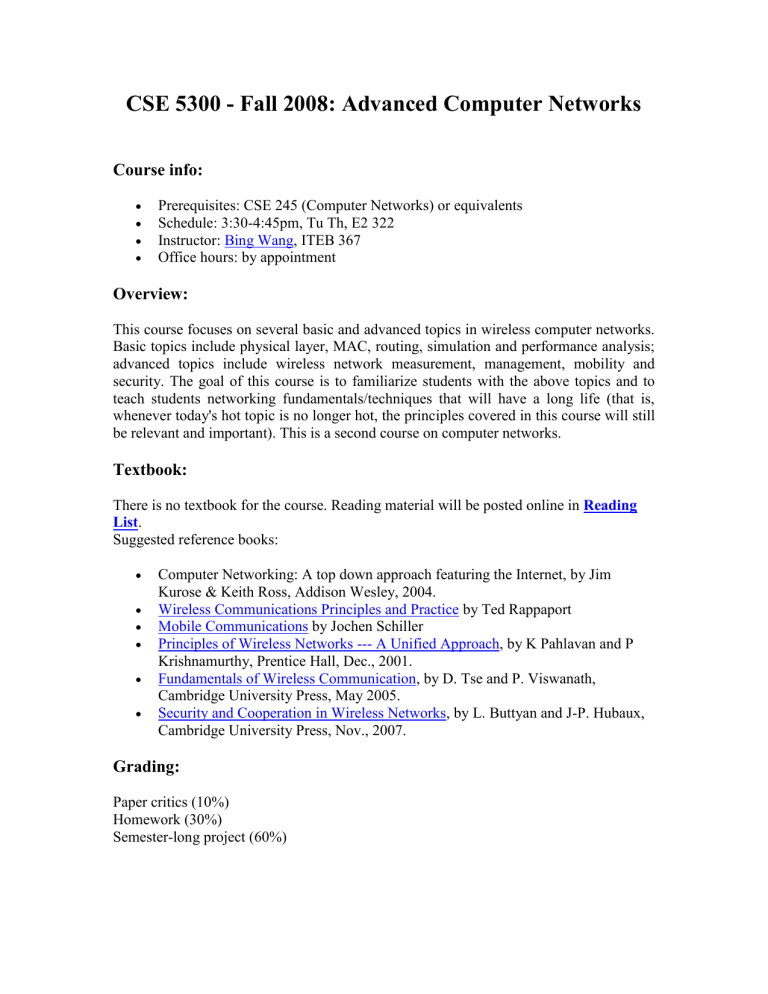CSE 5300 - Fall 2008: Advanced Computer Networks Course info:

CSE 5300 - Fall 2008: Advanced Computer Networks
Course info:
Prerequisites: CSE 245 (Computer Networks) or equivalents
Schedule: 3:30-4:45pm, Tu Th, E2 322
Instructor: Bing Wang , ITEB 367
Office hours: by appointment
Overview:
This course focuses on several basic and advanced topics in wireless computer networks.
Basic topics include physical layer, MAC, routing, simulation and performance analysis; advanced topics include wireless network measurement, management, mobility and security. The goal of this course is to familiarize students with the above topics and to teach students networking fundamentals/techniques that will have a long life (that is, whenever today's hot topic is no longer hot, the principles covered in this course will still be relevant and important). This is a second course on computer networks.
Textbook:
There is no textbook for the course. Reading material will be posted online in Reading
List .
Suggested reference books:
Computer Networking: A top down approach featuring the Internet, by Jim
Kurose & Keith Ross, Addison Wesley, 2004.
Wireless Communications Principles and Practice by Ted Rappaport
Mobile Communications by Jochen Schiller
Principles of Wireless Networks --- A Unified Approach , by K Pahlavan and P
Krishnamurthy, Prentice Hall, Dec., 2001.
Fundamentals of Wireless Communication , by D. Tse and P. Viswanath,
Cambridge University Press, May 2005.
Security and Cooperation in Wireless Networks , by L. Buttyan and J-P. Hubaux,
Cambridge University Press, Nov., 2007.
Grading:
Paper critics (10%)
Homework (30%)
Semester-long project (60%)
Class participation: You are expected to attend all the classes and actively participate in the class (asking/answering questions and contributing to class discussion).
Paper critics: You are required to write reviews for three papers from the reading list. Your reviews have to be in your own words and include the following: o A brief summary of the paper (keep the paper aside, sit, relax, think, and o o o write what comes to you).
A list of the strengths of this paper.
A list of shortcomings/limitations/open-issues.
How well did you understand the paper? List what you found difficult to grasp. o What have you learned as a by-product of reading this paper (e.g., some new algorithm you were not aware of)? If yes, write a few sentences about it and how it might be useful to you someday.
Homework: We will have two written assignments and one programming assignment on ns simulation.
Course project: A major component in this course is a semester-long project.
You can work in a group of 2 students (you can work alone or in a group of 3 if there is a justified reason). Once the groups are fixed, I will help you to determine a topic based on your preferences and suggestions. You are expected to write a proposal (5%), a mid-term report (5%), a final report (35%) and do a mid-term and final presentation in class (accounting for 5% and 10% respectively of your grade). Your grade will be based on the quality of your work and oral presentation. Please follow either ACM SIG proceeding format or IEEE format for your proposal, midterm and final reports. o Proposal: should include at least the introduction, related work, project overview, and references. You should describe the problem, why it is o o o interesting, what are the challenges and existing work.
Midterm report: should describe your progress, problems/issues that you encountered and solved. The purpose is to check your progress, summarize initial results and collect feedbacks from the instructor.
Final report: should be a complete report of your project, containing most components that you would have included for a conference paper. If simulation and/or implementation are involved in your project, welldocumented codes should be submitted electronically in company with the final reports.
Class presentation: is a short presentation (within 10 slides) for midterm and longer version (within 20 slides) for final. Students in the team are expected to share the task of presentation. This will provide you an opportunity to give talks and collect comments from your peer students and the instructor.

